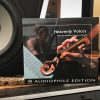
Review: Waldorf Iridium Keyboard
The 16-voice polyphony, duo-timbral dream machine wins a 49-note Fatar key bed.
Review: Christopher Holder
You might lust after the latest Tesla motor car. The Model S, for example, represents the bleeding edge in what a EV could and should be. It can drive itself and, if you option-up enough, it’ll probably give you a back massage and a third-wave latte on the morning commute.
I might, on the other hand, lust after a BMW M3. The visceral connection between the power plant and the road; the roar of the engine… It’s the culmination of a 100 years of motor car design, representing thousands of moving parts, spinning and meshing with miniscule tolerances — more complex than a Swiss watch and loads more fun.
Both are priced around the same. Both are astonishingly good cars. But they are very different.
Waldorf’s Iridium is not unlike a brand new Tesla. It’s an astonishingly good polysynth and entirely digital. It can produce growling synth basses easily capable of scaring small children, beautifully ethereal pads that can make a grown man cry, and everything in between.
If the Iridium is like a Model S, then the M3 equivalent would be the likes of the Arturia PolyBrute or the Sequential Prophet 6 — analogue to the core and the epitome of what people love about their VCOs and VCFs. What they lack in variety of tonal palette they make up for in personality and desirability.
So if you’re in the market for a polysynth, but it has to be analogue, then this is not the droid you’re looking for. But a word of caution, you could be doing yourself a disservice by limiting your options in this way.
TESTING THE METAL
So what is Iridium… apart from being a hard, dense silvery-white metal with an atomic number of 77? It’s a multi-faceted dual-voice polysynth with a variety of synth models, a host of sound shaping facilities, 40-slot modulation matrix, effects and more.
Iridium offers five different synthesis models for each of the three oscillators:
Wavetable: What Waldorf is best know for; like a Microwave under the bonnet.
Waveform (Virtual Analogue): All the usual subtractive synth sounds here.
Particle (Sampling and Granular Sampling): Use Iridium’s samples or input your own.
Resonator: Bell sounds and the like.
Kernels: Kinda like FM synthesis on steroids.
NEED TO KNOW
Waldorf Iridium Keyboard

GETTING AROUND
The extra real estate afforded by the 49-note keyboard form factor means the layout of this Iridium is more relaxed than the module. You have the three oscillator controls on the left, the generous touchscreen display in the middle (with attendant pots), and the filter and envelopes on the right.
It’s logically laid out. The controls feel great. The touchscreen isn’t overly relied on. Mostly there’s a pot to make an adjustment. That said the screen fills the breach when you need to interact with it — like drawing in a modulation curve, for example. Often my (albeit pincer-like piano-player’s) fingers can find it hard to interact with certain synth touchscreens, but I found the Iridium’s accessible and responsive.
Patches load up almost instantly, except Particle patches which rely on larger samples. You can switch smoothly from one patch to the next without cutting off the previous sound (essential for performing). Speaking of which, there’s a Performance mode that gives you access to your gig’s patches, along with a Kaoss pad-style mod canvass you can mess with, the arp/sequencer section, and more. It’s a good feature.
The synth-action Fatar key bed itself is primo. It responds to poly touch and is beautiful to play. It’s a little too sensitive to aftertouch for my taste. I find myself accidentally setting it off when I start to dig in. Perhaps there’s a setting to adjust sensitivity buried deep in a menu somewhere.
SONIC SMORGASBORD
This is a review of the Iridium Keyboard and not the original Iridium (released in 2020). Chances are, if you’re reading this review you’ll already have read Iridium reviews and heard what it sounds like.
Personally, I’d not spent any worthwhile time with Iridium at all until I started messing with the keyboard version. So I’ll give you my impressions.
First up, it’s just so much more versatile than other desirable 16-voice polys, because of the five different voice modes.
The sounds are neatly categorised and explorable. Which is just as well as there’s a wealth of preset options and even more space for your own creations.
There’s often a grace and refinement about the Iridium sounds. I rarely feel like Iridium will growl, snarl and take my head off. Which gives you a sense of what the smooth digital filters are like. There’s character, for sure, and complexity, but a level of cool restraint as well.
The sonic depth is often evident. Yes, it can emulate a MiniMoog bass sound but that’s not where Iridium’s sweet spot lies, I suspect.
All that said, you can’t typecast Iridium because you could just as easily spend a day only exploring its wavetable sounds, it FM synth-like sounds of the Kernel voices, the bells and percussion of the Resonator… you get my point.
My personal favourite are some of the pads which I got lost in for hours. Some have rhythmic qualities that are fun to sync to tempo, without sounding like a wave sequence.
Given Iridium’s depth, programming it is a real joy. This is a credit to Waldorf’s user interface.
I challenge you to find a PC+controller experience that even remotely approaches what Iridium can do



CONCLUSION
There’s a lingering suspicion of an all-digital polysynth — a ‘VSTi with knobs on’, as I’ve heard it said. Well, I challenge you to find a PC+controller experience that even remotely approaches what Iridium can do. Long after your licenses have timed out or been updated out of existence, the Iridium will load up just as quickly as it does today and reliably provide you with the same array of tones and textures (not withstanding future Waldorf updates you can opt into).
‘What about resale value, though? Surely the analogue engine of a Moog will maintain its value more than the Waldorf?’ If collectability is a concern then that’s a whole other Pandora’s box of worms. But again, I challenge you: open your eyes and take a look at the Iridium. It’s stunning — a beautiful piece of industrial design. It will remain a desirable piece of kit for a very long time. What happens in 20, 30 or 40 years is entirely in the lap of the synth gods, and I wouldn’t be basing my superannuation fund around synth investments!
Oh, and don’t forget the luxurious Waldorf Quantum, which combines an analogue filter section with its three digital oscillators. To strangle my metaphor, I guess the Quantum is more like a Ferrari hybrid. And who wouldn’t want one of those?
16-voice polyphony, duo-timbral
3 Oscillators
Oscillator Modes:
- Wavetable
- Waveform (VA)
- Particle (Sampling and Granular Sampling)
- Resonator
- Kernels (up to 6 sub-oscillators which can be interlinked through FM at audio rate)
3 Stereo Filters per voice
True stereo path
Dual Digital Filter:
- Two filters with independable modes
- 12/24dB LP/HP/BP in all combinations
- Nave, Largo, PPG, Quantum and StateVariable models
Digital Former:
Filter models from Waldorf Nave, Largo and PPG in HP/LP/BP/Notch
- Comb filter
- Bitcrusher
- Drive
- RingMod
- StateVariable mode
- Analyzer displayed in Filter view
- Filter curve moves when modulated (optional)
- Sophisticated filter routing options with modulatable panning and levels
Modulators:
- 6 Envelopes
- 6 LFOs
- Komplex Modulator (LFO/Envelope combination with user-definable shape)
Mod Matrix:
- 40 slots
- Fast assign mode
- One additional control amount per slot
- Identical Sources and Destinations can be used multiple times until the matrix is full
Keyboard:
- 49 keys Fatar TP/8SK keyboard
- Semi-weighted sensitive keys with polyphonic aftertouch
- Latch mode
Performance features:
- Arpeggiator
- Step sequencer with up to 32 steps for notes and parameters
- Favourites screen for quick patch recall
- Mod Wheel, Pitch Bend and Poly-Aftertouch
- MPE capable
- 6 Macro buttons (six freely-programmable buttons to switch on and off functions)
Screen:
Industrial-grade highly responsive touch screen
Patches:
- Over 1000 factory sounds
- Capacity of 7000 patch memory slots (numbers 0000-9999 can be used)
- Patches from Quantum can be loaded and vice-versa
- Category filter for patch list
- 2GB user sample flash memory
Connections:
- 2x TS output
- 2x TS input
- Headphones output with Gain control
- DIN MIDI In/Out/Thru
- USB Type B for MIDI connection to computers / DAWs
- USB Type A for direct connection of storage devices and MIDI controllers
- MicroSD slot
- Kensington lock
CV connections:
- 4 CV inputs plus Gate In, Trigger In, Clock In, Clock Out
- Inputs can be used as modulation sources in the Mod Matrix
























RESPONSES